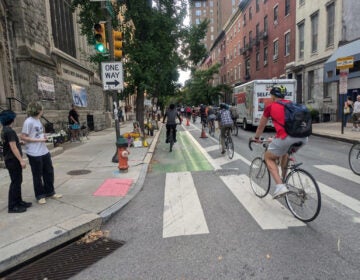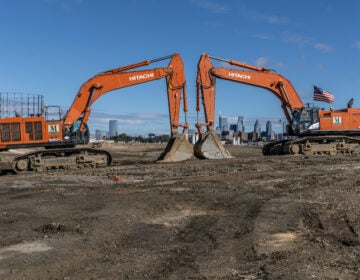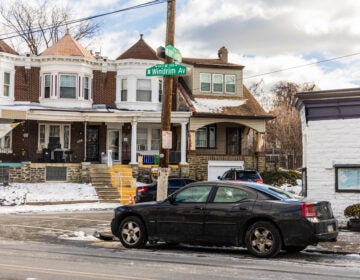Spring Garden bike lanes still on track to connect Delaware to Schuylkill River trails, for now
The 2.1-mile protected bike lane project, which includes upgrading several high-injury network intersections, is expected to be completed by 2029.
Listen 1:03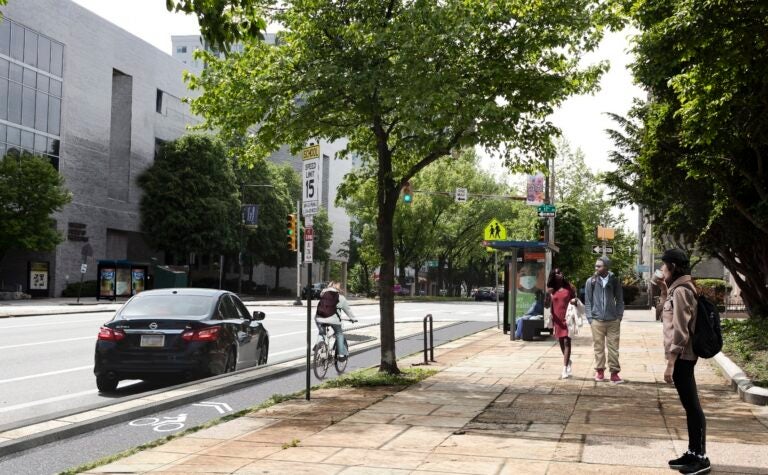
The planned Spring Garden Street connector is in the design phase for the next two years and is expected to open to the public by 2029. (Graphic renderings provided by the Philadelphia Planning Commission)
Have a question about Philly’s neighborhoods or the systems that shape them? PlanPhilly reporters want to hear from you! Ask us a question or send us a story idea you think we should cover.
Cycling advocates say riding along Spring Garden Street in Philadelphia is not for the faint of heart, at least for now.
White painted lines on the roadway are the only thing separating riders and traffic where vehicles are supposed to travel no faster than 25 miles an hour, but that’s not always the case in practice.
“Cars are able to pick up a lot of speed between traffic lights, it’s not reassuring to have speeding cars flying by you,” said Daniel Paschall, the Mid-Atlantic manager for the East Coast Greenway Alliance. “Philly has a lot of one-way streets that change and run into dead ends. So this is one of the few [streets] that can really connect you [across the city], so a lot of people use it despite feeling unsafe because it’s so direct and effective.”
But by 2029, the 2.1-mile stretch of Spring Garden between the Delaware River and Schuylkill River trails will be transformed into a safer and greener connector street for pedestrians, transit riders and bicyclists.
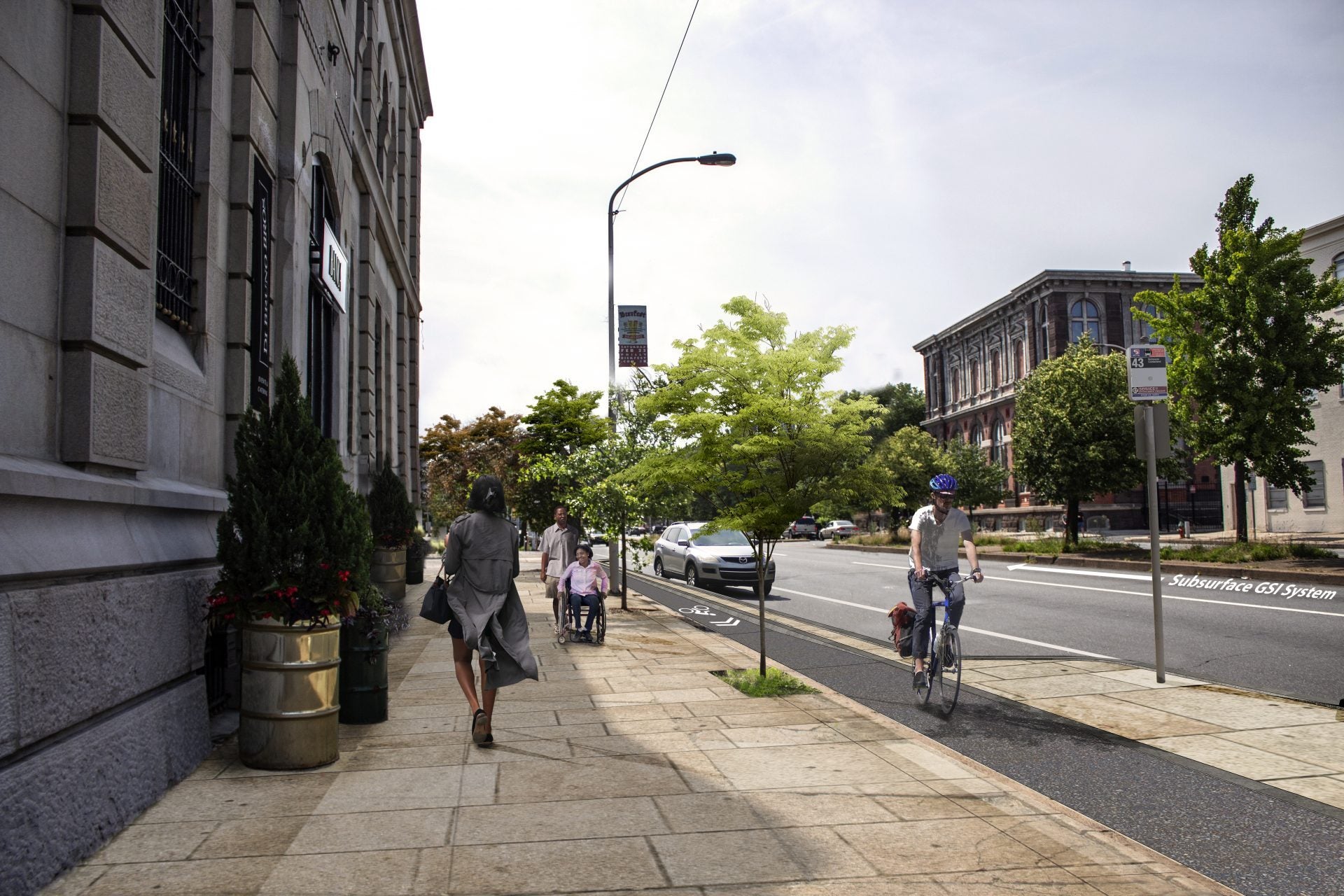
The $53 million plan, which includes a significant chunk of federal funding, is still on track, officials said.
The $21 million of federal funding stems from the Infrastructure Investment and Jobs Act under the Federal Highway Administration’s Carbon Reduction Program. The funding was then allocated by the Delaware Valley Regional Planning Commission to become a Transportation Improvement Program project in Philadelphia.
Plans include bike lanes near the sidewalk in both directions, protected by a concrete curb and parked vehicles separating cyclists from traffic. In some sections, the bike lane will be raised to the same level as the sidewalk.
There are also protections so bikers don’t get hit by doors of people entering or exiting the parked vehicles, Paschall said.
“There would be space for people to get in and out of their cars without conflicting with people biking,” he said.
The connector will also have floating bus islands, so buses won’t be stopping in the middle of the bike lanes. Additionally, shorter pedestrian crossings at intersections hope to reduce crashes.
After several rounds of public input, the design process is expected to take about two years, then a construction contract would be open for bids before a company is selected and road work begins.
“We’re funded through design. We’re funded through construction. We won’t speculate about anything else at this stage,” said Niño Ranjo, assistant chief engineer for the city’s Department of Streets. “We’re really pushing this project aggressively, it’s a priority for us.”
The design costs are covered by $500,000 of Automated Speed Enforcement funds, otherwise known as red light cameras; $1 million from the city of Philadelphia; $1 million from the Pennsylvania Department of Conservation and Natural Resources; and about $2 million from the William Penn Foundation.
At first, the Spring Garden Street improvements were only going to be a bike trail along an expanded median, but now they are considered a complete streets project, involving the revamping of nearly 22 intersections, including timing traffic lights and moving bike lanes to the curbs.
“The project grew, it’s really much more than just that. It’s about improving and upgrading the signals, all pedestrian crossings, [and] stormwater. It’s bringing many benefits in one big project,” said Sarah Clark Stuart, trails manager for the Department of Streets.
The bike lanes would cross several intersections in the city’s high-injury network — meaning frequent crashes involving pedestrians or bicyclists. They would connect to existing bike lanes on 5th, 6th, 13th, 15th and 22nd streets.
“So by reducing conflicts, by slowing the traffic, the vehicular traffic down, keeping it within the speed limit and shortening the crossing distances that pedestrians will have to cross, all of that will contribute towards reducing the number of crashes that do occur,” Clark Stuart said.
Officials hope that retrofitting the roadway and adding more green space along the median and sidewalks will increase foot traffic to neighborhoods and businesses along the corridor.
The Spring Garden connector is one slice of federal money that has not been frozen by President Donald Trump’s administration, which has targeted other programs funded by the Infrastructure Investment and Jobs Act, such as Philadelphia’s $12 million environmental justice effort to plant more urban trees in underserved neighborhoods.
Pennsylvania Gov. Josh Shapiro successfully fought to unfreeze $2.1 billion of federal funding after filing a lawsuit against the Trump administration’s executive orders. That included freezing funding for Infrastructure Investment and Jobs Act projects.
There have been many decisions made at the federal level without much warning; the project is fully funded, for now.
“As far as we know, yes, but DVRPC is waiting for clarification on the impact of the recent executive orders and memos, awaiting guidance from our department of transportation and federal partners,” said Joe Banks, manager of the Office of PA Project Implementation for the Delaware Valley Regional Planning Commission. “Anything that’s on the [Transportation Improvement Program], we’re going forward. Construction could take one to two years depending but the contractor would really put that schedule out.”
And the new Spring Garden corridor would fill a big gap in the city’s protected bike network that can sometimes lack continuity, said Philadelphia Bicycle Coalition Executive Director Chris Gale.
“When you look at where the original bike lanes were built, there wasn’t always a plan. And over the last decade or so, there’s been a plan that the city has slowly been implementing to make sure there’s that connected bike lane network,” Gale said. “Spring Garden is going to be the next big east-west connector.”
It would also connect Philadelphia to the East Coast Greenway, a bike trail that will eventually connect Maine to Florida; about 1,000 miles of the 3,000-mile project is already complete.
But waiting another four years for protected bike lanes isn’t easy, Paschall said.
“I totally get the frustration of like, why does this take so long, but thankfully they have funding,” he said. “This has had incredible amounts of political support locally, at the state and federal level, and we want to keep it that way because we know that anything can snag it and delay it. It’s really going to redefine these neighborhoods, and I think it’ll set the city up for a great future.”
Editor’s note: The William Penn Foundation is a WHYY supporter. WHYY News produces independent, fact-based news content for audiences in Greater Philadelphia, Delaware and South Jersey.

Subscribe to PlanPhilly
WHYY is your source for fact-based, in-depth journalism and information. As a nonprofit organization, we rely on financial support from readers like you. Please give today.



